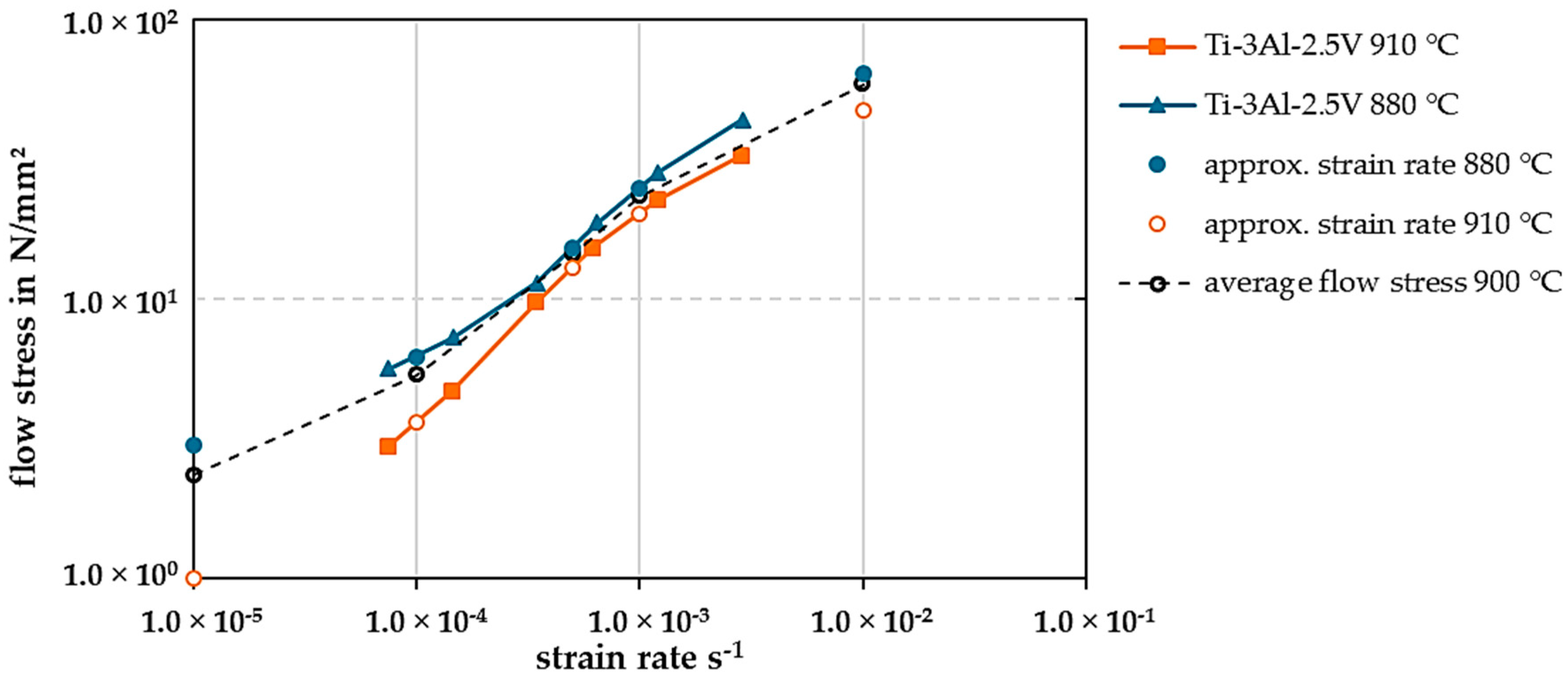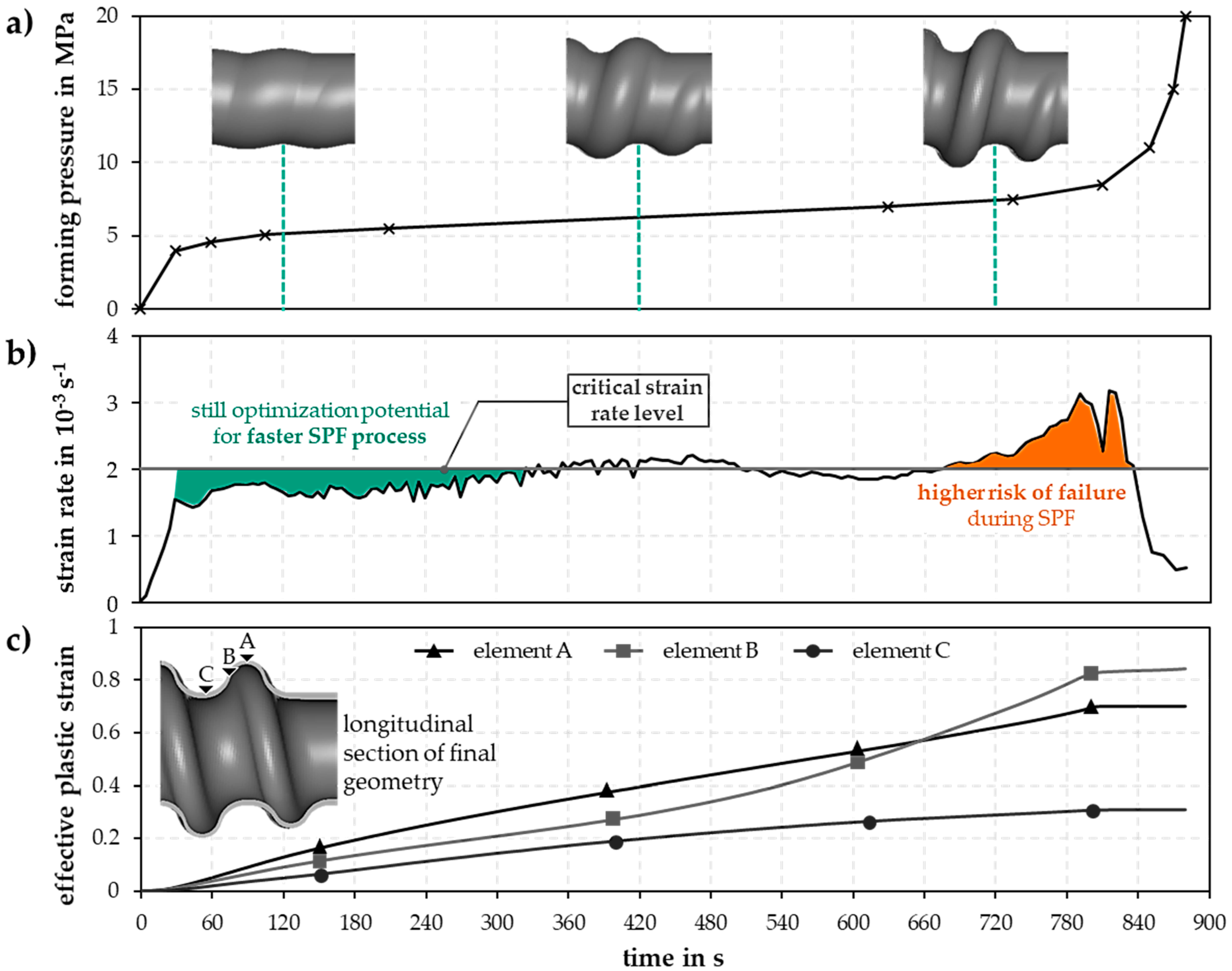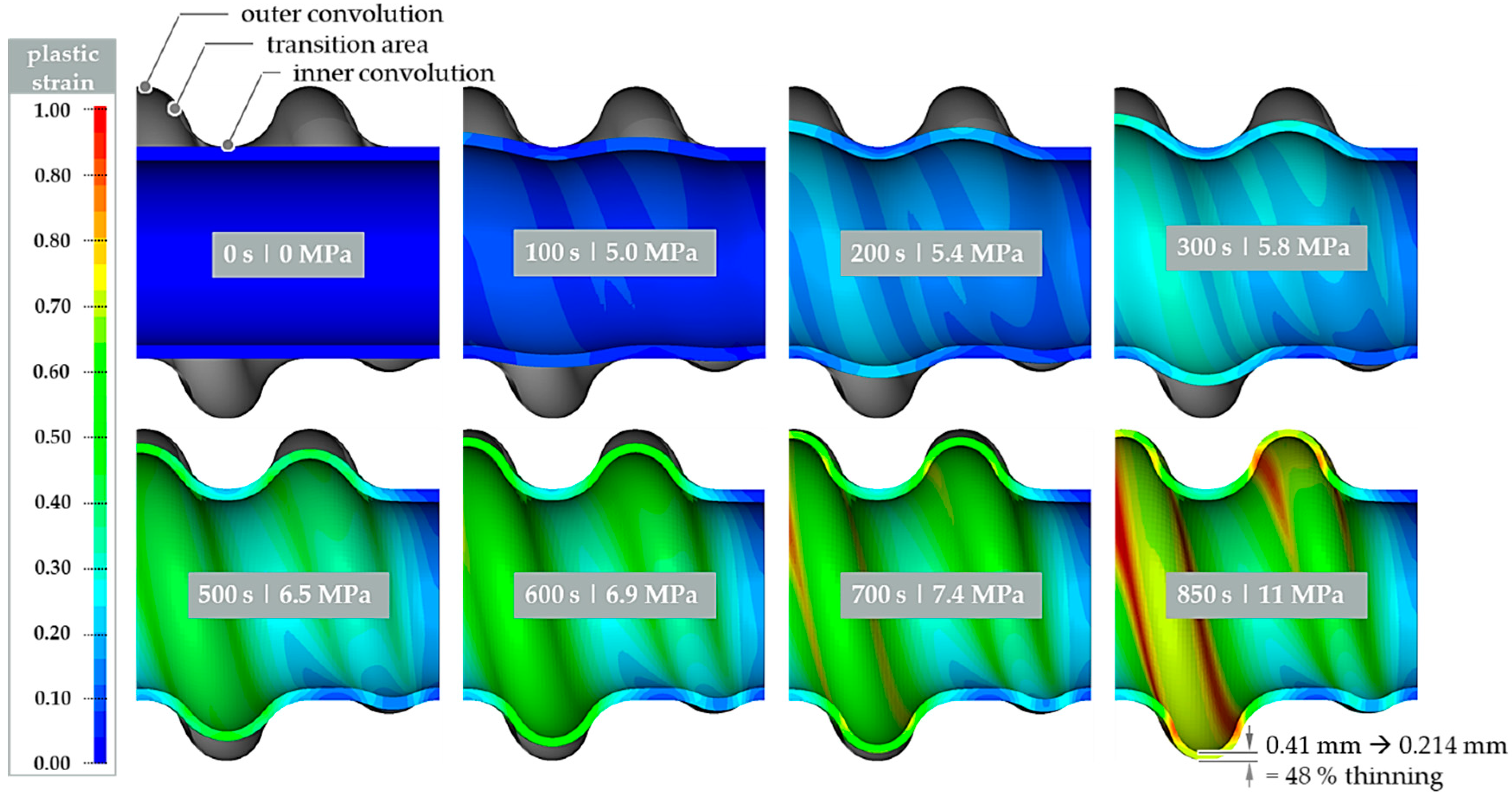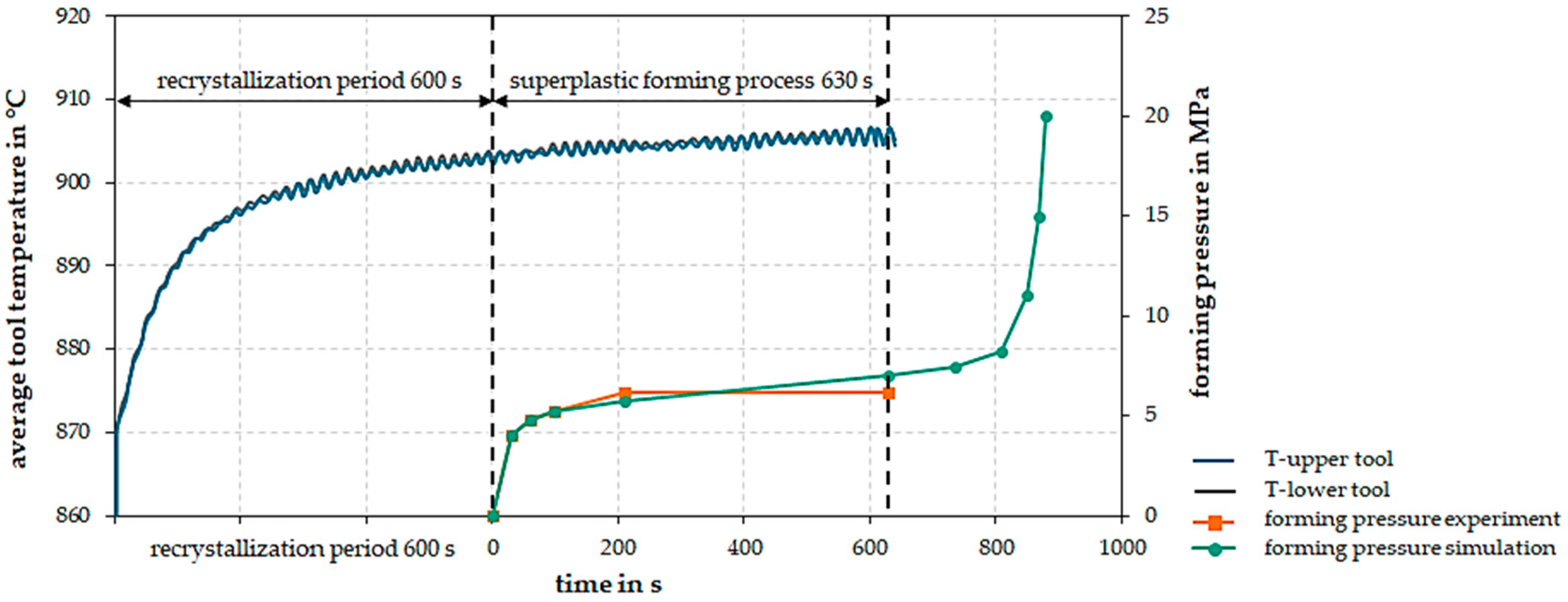Process Development for a Superplastic Hot Tube Gas Forming Process of Titanium (Ti-3Al-2.5V) Hollow Profiles
Abstract
:1. Introduction
2. Objective
3. Process Design and Simulation
4. Tool Concept
5. Results
6. Summary and Conclusions
Author Contributions
Funding
Conflicts of Interest
References
- Singh, P.; Pungotra, H.; Kalsi, N.S. On the characteristics of titanium alloys for the aircraft applications. Mater. Today Proc. 2017, 4, 8971–8982. [Google Scholar] [CrossRef]
- Titan und Titanlegierungen. Vortragstexte eines Fortbildungsseminars der Deutschen Gesellschaft für Materialkunde e.V. In Zusammenarbeit mit dem Institut für Werkstofforschung des GKSS-Forschungszentrum Geesthacht GmbH; Peters, M., Ed.; [3., völlig neu bearb. Aufl.], 3. Nachdr; Wiley-VCH: Weinheim, Germany, 2010; ISBN 978-3-527-30539-1. [Google Scholar]
- RMI Titanium Company. Titanium Alloy Guide. 2000. Available online: https://link.springer.com/content/pdf/10.1007/s00170-017-0642-1.pdf (accessed on 16 June 2020).
- Lee, S.W. Study on the forming parameters of the metal bellows. J. Mater. Process. Technol. 2002, 130, 47–53. [Google Scholar] [CrossRef]
- Faraji, G.; Mashhadi, M.M.; Norouzifard, V. Evaluation of effective parameters in metal bellows forming process. J. Mater. Process. Technol. 2009, 209, 3431–3437. [Google Scholar] [CrossRef]
- Bakhshi-Jooybari, M.; Elyasi, M.; Gorji, A. Numerical and experimental investigation of the effect of the pressure path on forming metallic bellows. Proc. Inst. Mech. Eng. Part B J. Eng. Manuf. 2009, 224, 95–101. [Google Scholar] [CrossRef]
- Liu, J.; Liu, Y.; Li, L.; Li, X. Springback behaviors of bi-layered non-homogeneous bellows in hydroforming. Int. J. Adv. Manuf. Technol. 2017, 93, 1605–1616. [Google Scholar] [CrossRef]
- Sedighi, M.; Shamsi, M. A new approach in producing metal bellows by local arc heating: A parametric study. Int. J. Adv. Manuf. Technol. 2017, 93, 3211–3219. [Google Scholar] [CrossRef]
- Zhang, Z.; Furushima, T.; Manabe, K.-I.; Tada, K.; Sasaki, O. Development of dieless metal bellows forming process with local heating technique. Proc. Inst. Mech. Eng. Part B J. Eng. Manuf. 2015, 229, 664–669. [Google Scholar] [CrossRef]
- Yuan, Z.; Huo, S.; Ren, J.; Han, J. Study on the hydroforming technology of reinforced s-shaped bellows. Int. J. Adv. Manuf. Technol. 2019, 103, 2541–2552. [Google Scholar] [CrossRef]
- Wang, G.; Zhang, K.F.; Wu, D.Z.; Wang, J.Z.; Yu, Y.D. Superplastic forming of bellows expansion joints made of titanium alloys. J. Mater. Process. Technol. 2006, 178, 24–28. [Google Scholar] [CrossRef]
- Odenberger, E.-L. Concepts for Hot Sheet Metal Forming of Titanium Alloys. Ph.D. Thesis, Luleå Tekniska Universitet, Luleå, Sweden, 2009. [Google Scholar]
- Sergueeva, A.V.; Stolyarov, V.V.; Valiev, R.Z.; Mukherjee, A.K. Superplastic behaviour of ultrafine-grained Ti–6A1–4V alloys. Mater. Sci. Eng. A 2002, 323, 318–325. [Google Scholar] [CrossRef]
- Yoshimura, H. Ultra-fine-grain refinement and superplasticity of titanium alloys obtained through protium treatment. Int. J. Hydrogen Energy 2002, 27, 769–774. [Google Scholar] [CrossRef]
- Salam, A.; Hammond, C. Superplasticity in Ti-3Al-2.5V. J. Mater. Sci. Lett. 2000, 19, 1731–1733. [Google Scholar] [CrossRef]
- Reimund, N. Hydro-Umformung; Springer: Berlin, Germany, 2007; ISBN 978-3-540-49013-5. [Google Scholar]
- Bach, M.; Degenkolb, L.; Reuther, F.; Psyk, V.; Demuth, R.; Werner, M. Conductive Heating during Press Hardening by Hot Metal Gas Forming for Curved Complex Part Geometries. Metals 2020, 10, 1104. [Google Scholar] [CrossRef]
- Drossel, W.-G.; Lies, C.; Albert, A.; Haase, R.; Müller, R.; Scholz, P. Process combinations for the manufacturing of metal-plastic hybrid parts. In IOP Conference Series: Materials Science and Engineering, Proceedings of the 18th Chemnitz Seminar on Materials Engineering—18. Werkstofftechnisches Kolloquium, Chemnitz, Germany, 10–11 March 2016; IOP Publishing: Bristol, UK, 2016; Volume 118, p. 12042. [Google Scholar] [CrossRef]
- Liu, G.; Wu, Y.; Wang, D.; Yuan, S. Effect of feeding length on deforming behavior of Ti-3Al-2.5 V tubular components prepared by tube gas forming at elevated temperature. Int. J. Adv. Manuf. Technol. 2015, 81, 1809–1816. [Google Scholar] [CrossRef]
- Bach, M.; Degenkolb, L.; Reuther, F.; Mauermann, R.; Werner, M. Parameter measurement and conductive heating during press hardening by hot metal gas forming. In IOP Conference Series: Materials Science and Engineering, Proceedings of the 38th International Deep Drawing Research Group Annual Conference (IDDRG 2019), Enschede, The Netherlands, 3–7 June 2019; IOP Publishing: Bristol, UK, 2019; pp. 3–7. [Google Scholar]
- Zheng, K.; Zheng, J.-H.; He, Z.; Liu, G.; Politis, D.J.; Wang, L. Fundamentals, processes and equipment for hot medium pressure forming of light material tubular components. Int. J. Lightweight Mater. Manuf. 2020, 3, 1–19. [Google Scholar] [CrossRef]
- Paul, A.; Werner, M.; Trân, R.; Landgrebe, D. Hot Metal Gas Forming of Titanium Grade 2 Bent Tubes; AIP Publishing: Melville, NY, USA, 2017; p. 050009. [Google Scholar]
- Liu, G.; Wang, J.; Dang, K.; Tang, Z. High Pressure Pneumatic Forming of Ti-3Al-2.5V Titanium Tubes in a Square Cross-Sectional Die. Materials 2014, 7, 5992–6009. [Google Scholar] [CrossRef]
- Liu, G.; Wu, Y.; Zhao, J.; Wang, K.; Yuan, S. Formability Determination of Titanium Alloy Tube for High Pressure Pneumatic Forming at Elevated Temperature. Procedia Eng. 2014, 81, 2243–2248. [Google Scholar] [CrossRef] [Green Version]
- Wu, Y.; Liu, G.; Wang, K.; Liu, Z.; Yuan, S. The deformation and microstructure of Ti-3Al-2.5V tubular component for non-uniform temperature hot gas forming. Int. J. Adv. Manuf. Technol. 2017, 88, 2143–2152. [Google Scholar] [CrossRef]
- Liu, G.; Wang, K.H.; Xu, Y.; Wang, B.; Yuan, S.J. An Approach to Improve Thickness Uniformity of TA15 Tubular Part Formed by Gas Bulging Process. AMR 2013, 712–715, 651–657. [Google Scholar] [CrossRef]
- Liu, G.; Wang, J.; Dang, K.; Yuan, S. The effect of pressurization path on high pressure gas forming of Ti-3Al-2.5V at elevated temperature. MATEC Web Conf. 2015, 21, 6007. [Google Scholar] [CrossRef]
- Wu, Y.; Liu, G.; Wang, K.; Liu, Z.; Yuan, S. Loading path and microstructure study of Ti-3Al-2.5V tubular components within hot gas forming at 800 °C. Int. J. Adv. Manuf. Technol. 2016, 87, 1823–1833. [Google Scholar] [CrossRef]
- Wang, K.; Liu, G.; Huang, K.; Politis, D.J.; Wang, L. Effect of recrystallization on hot deformation mechanism of TA15 titanium alloy under uniaxial tension and biaxial gas bulging conditions. Mater. Sci. Eng. A 2017, 708, 149–158. [Google Scholar] [CrossRef]
- Wang, K.; Liu, G.; Zhao, J.; Huang, K.; Wang, L. Experimental and modelling study of an approach to enhance gas bulging formability of TA15 titanium alloy tube based on dynamic recrystallization. J. Mater. Process. Technol. 2018, 259, 387–396. [Google Scholar] [CrossRef]
- Lee, Y.; Lim, J.; Yoon, E.; Song, Y.; Kwon, Y.; Moon, Y. Tube bulge forming for one-piece fabrication of multi-joint head tubes for Ti-alloy-body bicycles. Proc. Inst. Mech. Eng. Part B J. Eng. Manuf. 2015, 229, 639–646. [Google Scholar] [CrossRef]
- Winter, S.; Wagner, M.F.-X. On the effect of incremental forming on alpha phase precipitation and mechanical behavior of beta-Ti-10V-2Fe-3Al. IOP Conf. Ser. Mater. Sci. Eng. 2016, 118, 12026. [Google Scholar] [CrossRef] [Green Version]
- Winter, S.; Pfeiffer, S.; Bergelt, T.; Wagner, M.F.-X. Finite element simulations on the relation of microstructural characteristics and the formation of different types of adiabatic shear bands in a β-titanium alloy. IOP Conf. Ser. Mater. Sci. Eng. 2019, 480, 12022. [Google Scholar] [CrossRef]
- Tan, K.; Li, J.; Guan, Z.; Yang, J.; Shu, J. The identification of dynamic recrystallization and constitutive modeling during hot deformation of Ti55511 titanium alloy. Mater. Des. 2015, 84, 204–211. [Google Scholar] [CrossRef]
- Paul, A.; Reuther, F.; Neumann, S.; Albert, A.; Landgrebe, D. Process simulation and experimental validation of Hot Metal Gas Forming with new press hardening steels. J. Phys. Conf. Ser. 2017, 896, 12051. [Google Scholar] [CrossRef] [Green Version]
- Salam, A. Flow Stress-Strain Rate Behavior of Ti-3Al-2.5V Alloy at Low Temperatures in the Superplastic Range. J. Mater. Eng. Perform. 2012, 21, 253–256. [Google Scholar] [CrossRef]
- Nazzal, M.A.; Khraisheh, M.K.; Abu-Farha, F.K. The effect of strain rate sensitivity evolution on deformation stability during superplastic forming. J. Mater. Process. Technol. 2007, 191, 189–192. [Google Scholar] [CrossRef]
- Kim, T.W.; Dunne, F.P.E. Determination of superplastic constitutive equations and strain rate sensitivities for aerospace alloys. Proc. Inst. Mech. Eng. Part G J. Aerosp. Eng. 1997, 211, 367–380. [Google Scholar] [CrossRef]
- Alabort, E.; Putman, D.; Reed, R.C. Superplasticity in Ti–6Al–4V: Characterisation, modelling and applications. Acta Mater. 2015, 95, 428–442. [Google Scholar] [CrossRef] [Green Version]
- El-Morsy, A.; Akkus, N.; Manabe, K.; Nishimura, H. Evaluation of superplastic characteristics of tubular materials by multi-tube bulge test. Mater. Lett. 2006, 60, 559–564. [Google Scholar] [CrossRef]
- Reuther, F.; Mosel, A.; Freytag, P.; Lambarri, J.; Degenkolb, L.; Werner, M.; Winter, S. Numerical and experimental investigations for hot metal gas forming of stainless steel X2CrTiNb18. Procedia Manuf. 2019, 27, 112–117. [Google Scholar] [CrossRef]









© 2020 by the authors. Licensee MDPI, Basel, Switzerland. This article is an open access article distributed under the terms and conditions of the Creative Commons Attribution (CC BY) license (http://creativecommons.org/licenses/by/4.0/).
Share and Cite
Trân, R.; Reuther, F.; Winter, S.; Psyk, V. Process Development for a Superplastic Hot Tube Gas Forming Process of Titanium (Ti-3Al-2.5V) Hollow Profiles. Metals 2020, 10, 1150. https://doi.org/10.3390/met10091150
Trân R, Reuther F, Winter S, Psyk V. Process Development for a Superplastic Hot Tube Gas Forming Process of Titanium (Ti-3Al-2.5V) Hollow Profiles. Metals. 2020; 10(9):1150. https://doi.org/10.3390/met10091150
Chicago/Turabian StyleTrân, Ricardo, Franz Reuther, Sven Winter, and Verena Psyk. 2020. "Process Development for a Superplastic Hot Tube Gas Forming Process of Titanium (Ti-3Al-2.5V) Hollow Profiles" Metals 10, no. 9: 1150. https://doi.org/10.3390/met10091150





